
Abstract: The failure of work roll bearing of cold rolling mill leads to the rolling line shutdown, reduces the running rate of rolling mill and reduces the output. Cause bearing, bearing seat and accessories damage. Therefore, while absorbing the successful experience of other manufacturers, combined with the actual field conditions from the bearing failure causes and control measures, bearing quality, bearing management, rolling state and other aspects, summed up a set of effective measures to reduce the consumption of work roller bearings, improve the service life of bearings.
Key words: stripping; Cleaning cycle; Lubrication; To break; tension
1 Introduction
The steel four frame uses the type 330661CG four row tapered roller bearing. It has the advantages of small friction coefficient, high transmission efficiency, convenient use and maintenance, and can bear radial load and axial load at the same time. Due to some improper manufacturing, use, maintenance and other links, bearing failure often occurs.
In 2010, a total of 86 sets of working roll bearings were consumed in rolling mills, with an average monthly consumption of 7.16 sets, a maximum monthly consumption of 13 sets and a minimum monthly consumption of 4 sets. In view of the above situation, unstable factors existing in the use of bearings should be discovered as early as possible to minimize losses (Table 1, Figure 1).


Failure causes and control measures of work roll bearing of rolling mill (existing problems in use)
2.1 Stripping
When the bearing rotates under load, the raceway surface or rolling surface of the inner and outer rings presents a fish-scale peeling phenomenon due to rolling fatigue, as shown in Figure 2. Work roll bearing peeling generally has the following factors: the load is too large; Poor installation (non-linear), foreign body intrusion, water; Poor lubrication, improper lubricant, improper bearing clearance; Development caused by rust, erosion spots, abrasions and indentations.
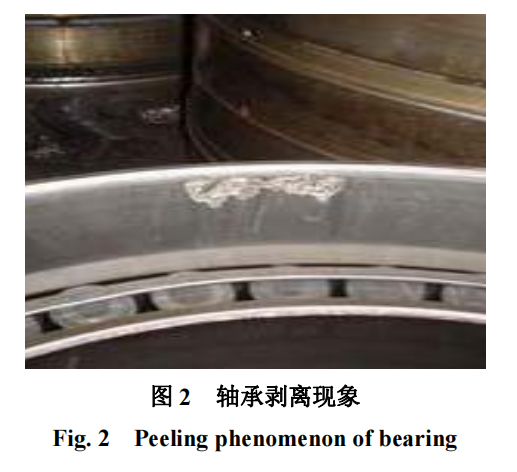
Method to prevent peeling of work roll bearing: check the size of the load and study the bearing used again; Improve the installation method, improve the sealing device; Use appropriate viscosity lubricants and improve lubrication methods; Check the accuracy of shaft and bearing box; Check the clearance.
2.2 Card Injury
The so-called stuck injury (FIG. 3) is surface damage resulting from the accumulation of small burns on the portion of the sliding surface injury.
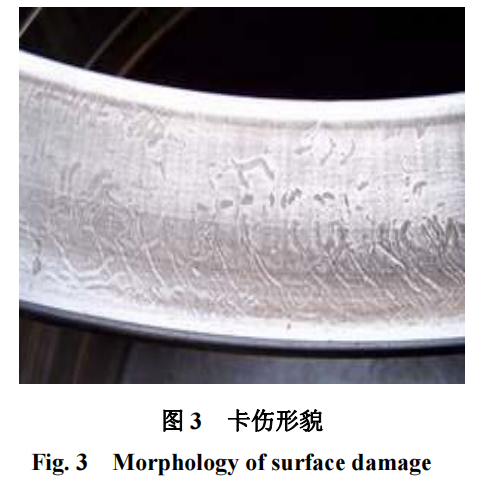
Deflection of incline and shaft; The accuracy of shaft and bearing box is poor. The method to prevent the work roll bearing from jamming: check the size of the load; Preloading should be appropriate; Check the accuracy of bearings, shafts and bearing boxes; Improve lubricants and lubrication methods.
2.3 Abrasion
The so-called abrasion (FIG. 4) refers to the surface damage on the raceway surface and rolling surface, which occurs with the accumulation of small burns caused by the sliding of the rolling and the thermal rupture of the oil film. Produces damage with sticky surface roughness.
Abrasion of work roller bearing generally has the following factors: high-speed light load, rapid acceleration and deceleration; Improper lubricant; Water intrusion, improper preloading. Method to prevent abrasion of work roll bearing: improve bearing clearance; Use lubricant with good oil film; Improve lubrication methods; Improve sealing device, improve preloading.
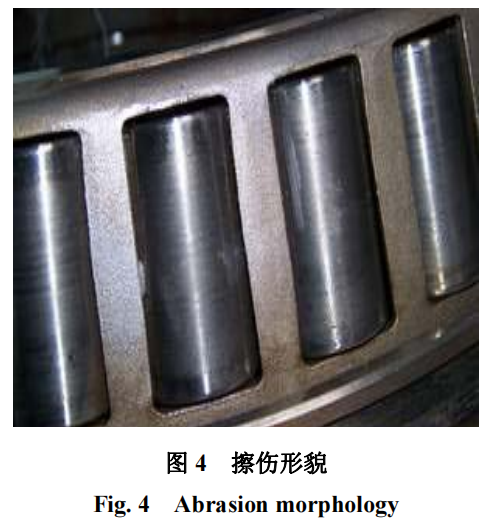
2.4 Fracture
The so-called fracture (FIG. 5) refers to the fracture of a small part due to the impact or excessive load on the retaining edge of the bearing ring or the local part of the rolling body; There is significant partial detachment or overall fracture.
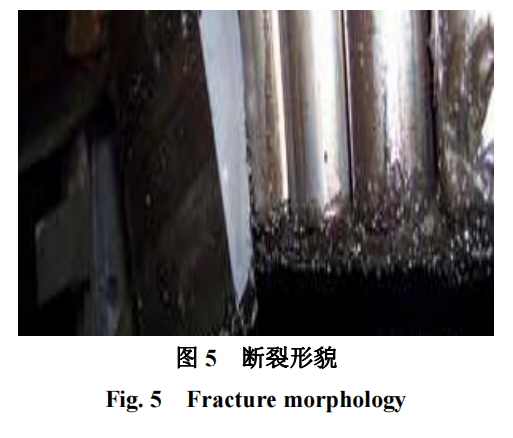
Work roll bearing fracture generally has the following factors: installation was hit; Instantaneous load is too large; Poor use of drop etc. The method to prevent the work roll bearing from breaking: improve the installation method and use appropriate tools; Correcting load conditions; The bearing is installed in place so that the guard edge is supported.
2.5 Indentation
The indentation on the raceway surface or rotating surface caused by biting into small metal powder, foreign matter, etc. (Figure 6). Due to the impact during installation, concave surface is formed on the spacing interval of the rolling body.
Work roller bearing indentation generally has the following factors: metal powder and other foreign bodies bite into; Excessive impact during loading or transportation; Impact bushing.
The method to prevent the indentation of the work roll bearing: improve the sealing device; Filter lubricating oil; Improve assembly and use methods.
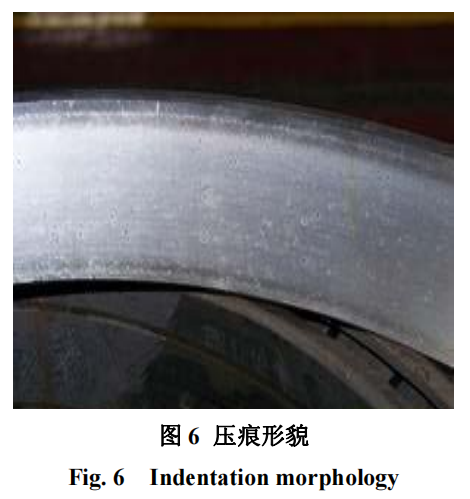
2.6 Burn
Raceway wheel, rolling body and cage heat rapidly during rotation until discoloration, softening, melting and breakage (Figure 7). Work roll bearing burns generally have the following factors: poor lubrication; Excessive load (excessive preload); High speed; Too small clearance; Intrusion of water and foreign bodies; The accuracy of shaft and bearing box is poor, and the deflection of shaft is large; The rolling body is stressed unevenly. Method to prevent burn of work roller bearing: select lubricant and lubrication method; Select the appropriate bearing type; Study fit, bearing clearance and preloading; Select the appropriate bearing clearance according to the working environment; Inspecting the sealing condition of bearing and improving the sealing condition; Check the accuracy of shaft and bearing box; Check the clearance of bearing box.

2.7 Rust and corrosion
The rust and corrosion of bearings include raceway wheel, pitted rust on the surface of the rolling body, overall rust and corrosion of the bearing (Figure 8). Work roll bearing rust, corrosion has the following factors: water, corrosive substances intrusion; Lubricants and rust prevention agents are not suitable; Attached to water droplets by condensation of steam; Heavy rust prevention during transportation is poor.
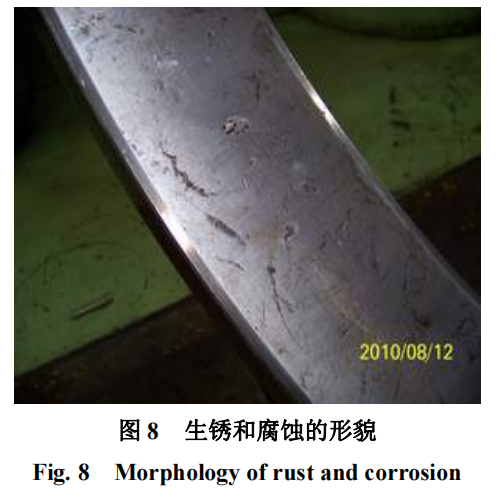
Methods to prevent rust and corrosion of work roller bearings: Avoid contact with water and corrosive substances as far as possible during storage and use. Take anti-rust measures when not in use or stopped; The sealing method used is not suitable, improve the sealing device; Improve storage and transportation conditions.
3. Problems that should be paid attention to in the use of work roll bearing of rolling mill
In this steel roll bearing with more rolling specifications, frequent roll change, roll bearing failure gradually increased, combined with the actual conditions, and a large number of data statistical analysis, the main factors that may affect the service status of work roll bearing, and lead to failure.
3.1 Bearing quality
Now the use of bearings has a number of brands of products (Chengdu, Luoyang, Japan NSK, Timken), the use of the comparison, analysis of the stage conclusion: Timken (3214.8km/ ten thousand yuan) >NSK (2243.2km/ ten thousand yuan) > Chengdu (1392.15km/ ten thousand yuan) > Luoyang (1183.56km/ ten thousand yuan) From the above data, it can be seen that imported bearings are better than domestic bearings.
3.2 Bearing management
To improve the quality of bearing assembly, the correct cleaning method determines the quality of bearing assembly. The first is the determination of the cleaning cycle (Table 2). The original cleaning cycle is: 12 months/time on the driving side of the mill and 6 months/time on the operating side of the mill. The original bearing cleaning cycle did not take into account the overhaul and shutdown of the rolling mill, as well as the maintenance time of the bearing, which could not truly reflect the use of the bearing. According to the actual running time of the bearing, a new bearing cleaning cycle was formulated, and a special person was assigned to track the actual running time of the bearing. The cleaning cycle after adjustment is shown in Table 2.

Through the adjustment of cleaning cycle, find the unstable factors in use in time. Secondly, strict implementation of effective management system is to ensure that bearings in machine operation must be cleaned strictly according to the working roller bearing cleaning cycle; Strictly implement the cleaning and replacement system of oil-gas lubricated joints, clean and check oil-gas lubricated joints regularly or during the maintenance of rolling mill, and replace them in time when problems are found; Check and adjust the bearing housing box size regularly to ensure the matching size of the box; Check the stop block regularly, and adjust and replace the serious wear in time.
3.3 Rolling state problem
Rolling condition is very important for bearing use. One is the installation accuracy, to ensure that the roller and bearing installed axial parallel, avoid cross rolling. The second is the lubrication problem. The oil and gas lubrication method used now is oil and gas lubrication. Its advantage is that it can make the bearing box produce positive pressure, the emulsion can not enter the box, prevent lubricating oil emulsification, maintain a certain oil film, and also make the bearing cool. The original long-term use of domestic oil-gas lubrication joint processing accuracy is not high, the interchangeability is not good, and often damaged, blocked, resulting in bearing oil supply obstruction, oil-gas lubrication alarm, last year replaced by imported joint (REBS), after replacement, oil-gas lubrication alarm frequency of rolling mill significantly reduced, improve the lubrication effect of rolling mill work roll bearing. The third problem is the high inclination value in rolling. Before and after each support roll is put on the machine, the roll shape shall be tested in detail and recorded. For bearing seat, upper and lower backing plate and shaking plate, regular spot inspection shall be carried out by special personnel in addition to routine inspection before each roll change. The third problem is the tension fluctuation between the frames. By optimizing the tension between mill stands, the two-side tension detection is restored, and the tensiometer, tension roll and dam roll are calibrated regularly to ensure the consistency of tension detection standards. The rolling parameters (incline value, rolling force deviation, tension, rolling speed, etc.) reflecting rolling state were recorded and analyzed.
4 Improvement Effect
Through the above three aspects of in-depth management, effectively reversed the previous rolling mill work roll bearing failure frequently situation, in 2011 compared with 2010 significantly reduced. The bearing consumption of rolling mill work roll in 2011 is shown in Table 3.
As can be seen from Figure 9, the bearing consumption of work rolls of rolling mills decreased by 30.2% (86-60/86) in 2011 compared with 2010.
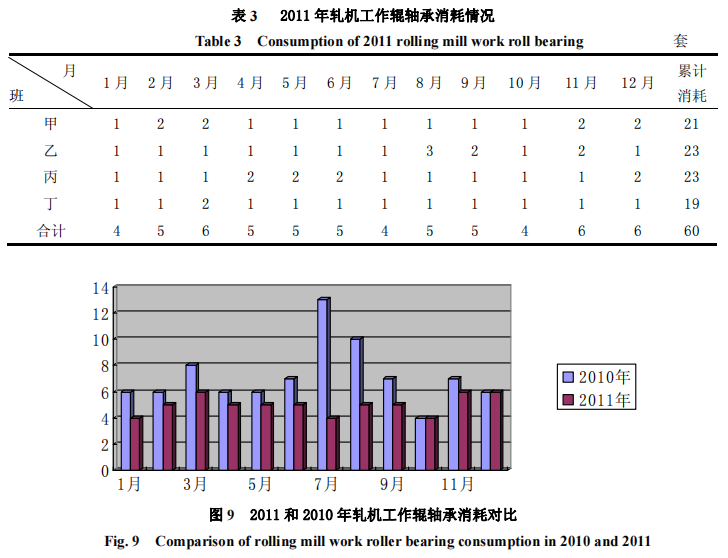
5 Conclusion
According to the analysis of the failure causes and control measures of the work roll bearing of rolling mill, the failure factors of the possible bearing are explained, and the simple opinions and suggestions on the control measures and methods are put forward to play a role in the correct use of the bearing.
References: [1] Rolling Bearing for Steel Rolling Machinery, Metallurgical Industry Press.
This article is from cold rolling sheet Mill of Benxi Iron and Steel Co., LTD., by rolling mill bearing finishing and publishing, copyright belongs to the original author. Reprint please indicate the source, if there is infringement, please contact us to delete.